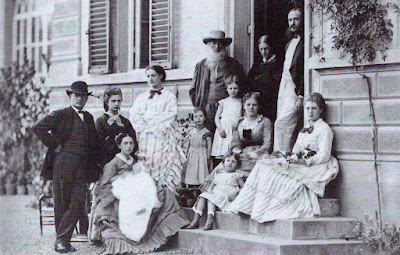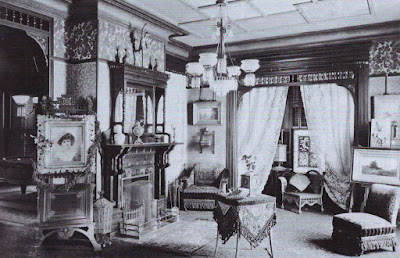When I have a free hour or two - an increasingly rare event - I like to wander the byways of Florence in search of less known corners of beauty and history.
Viale Poggio Imperiale, starting at
Porta Romana and running uphill all the way to
Arcetri is one productive hunting ground, lined as it is with beautiful villas, each with a story to tell. The avenue leads to the
Medicean Villa del Poggio Imperiale which belonged to the Medici Grand Ducal family from 1565 until 1738, but which reached its architectural peak under the Habsburg Lorraines, the successors to the Ducal Medici as rulers of Florence and owners of the villa. It later became, and still is, an exclusive girls' boarding school, the Istituto Statale della Ss. Annunziata, but the magnificent imperial rooms are open to the public one day a week.
 |
| One of the imperial rooms of Villa Poggio Imperiale in Florence, Italy |
A more modest but in some ways much more attractive villa on Poggio Imperiale belonged to
Longworth Powers, a sculptor and photographer. Longworth was the son of
Hiram Powers (1805 - 1873) who was an extremely successful American neoclassical sculptor, Swedenborgian and spiritualist, who moved to Florence in 1837 and settled on the Via Fornace,
where he had access to good supplies of marble and to traditions of
stone-cutting and bronze casting. He remained in Florence until his death, turning out marble busts and statues that were often reproduced in large numbers by his workmen and which sometimes fetched thousands of dollars. His studio was a fashionable stop on any American's grand tour. One of Longworth's brothers, Preston Powers, followed in his father's footsteps, first in America and then in Florence, but without success, and he died penniless in Florence in 1931.
 |
| The Longworth family in Florence - Hiram top centre. |
Longworth Powers was eventually more successful than his brother
Preston. He was the eldest son of Hiram and in his early life he
struggled to establish a career, failing to persevere at any task for
long, a fact that continually frustrated his successful father.
Longworth enrolled at the United States Military Academy at West Point,
where his family hoped that the education and discipline would would have beneficial effects, but he was "asked to leave" after only one semester. He then
attended Rensselaer Polytechnic Institute in upstate New York, but
failed to stay long enough to earn a degree. His father thought
Longworth might do better in Florence and so put him to work as
bookkeeper in his studio while teaching him the basics of sculpture.
Longworth created portrait busts and idealised pieces in a softer more romantic
neoclassical style than his father, but his interest soon waned, and Hiram sent him back
to America.
 |
| Flora (1880) is clearly indebted to Hiram Powers's allegorical busts but in a more romantic style |
By 1860, Longworth was back in Florence and began working as a
photographer. He was a great success, creating portraits of the prominent men
and women in the city, as well as selling photographs of Florentine
landmarks and works of art. He created a great many plaster busts of the
famous and not so famous visitors and residents in Florence and bought
himself a villino on Viale Poggio Imperiale, with an annex which he turned into a photographic
studio.
 |
| The villa and studio of Longworth Powers on Viale Poggio Imperiale |
 |
| The living room of the Powers villa in Florence - high Victorian! |
Photographs and plaster busts by Longworth Powers still come up on the market. His photographic portfolio in preserved in the Gabinetto
Vieusseux. Alas, a search of the Florence white pages suggests that the Powers family is extinct here.
 |
Don't forget to visit my Tuscany
Travel Guide!
Up-to-date news on what to see and where to stay in Chianti and all of Tuscany.
Tuscany Travel Guide
|
|
Author: Anna Maria Baldini











